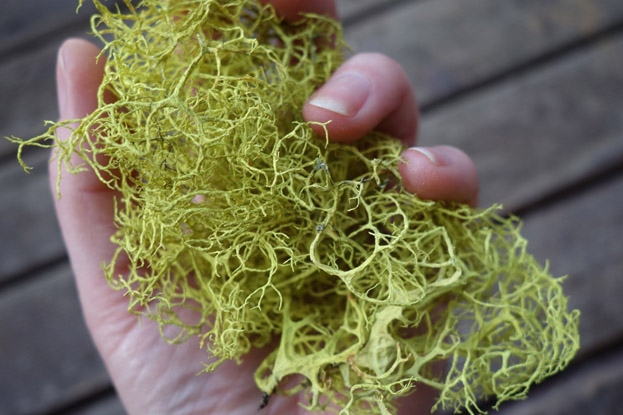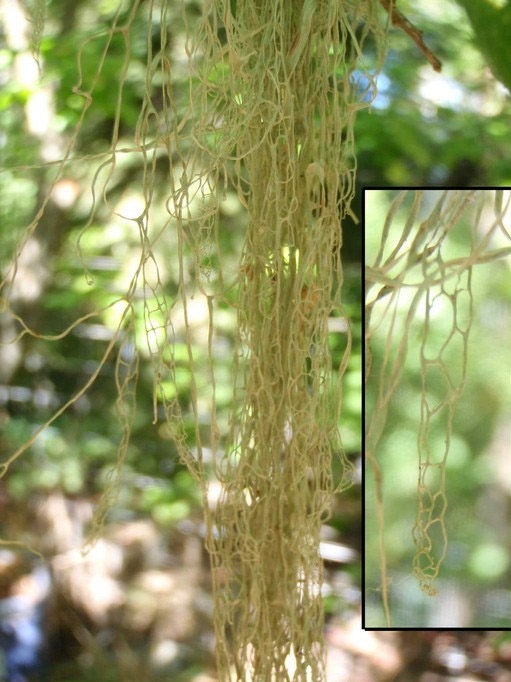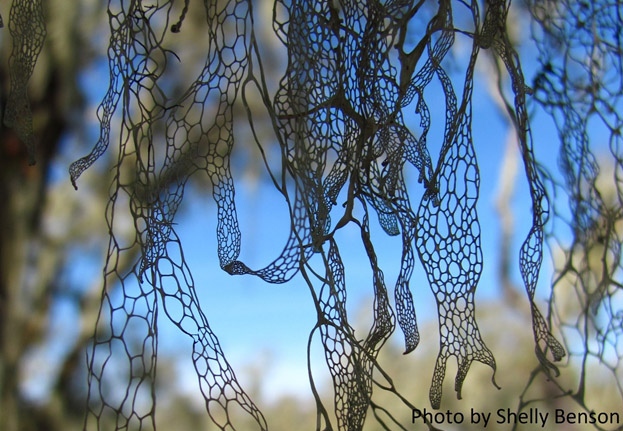|
| |
Lichen Foray ReportTheresa HalulaLichens are members of the fungi kingdom, mutualists or symbiotes, living as partners sharing resources between organisms, conceptually similar to the more often discussed mycorrhizae. 1,900 species of lichens that living in California. The March Lichen Foray found representative species from three basic groups known as foliose, fruticose, squamulose, and crustose lichens. Lichen are composed of a thallus [body] and a holdfast [foot]. A lichen is not one single organism; they form as a symbiotic relationship of a photobiont such as green algae or less commonly cyanobacteria and one, two or more mycobionts. The foliose lichens are “leafy” looking seen frequently on trees and shrubs. These are loosely attached can be picked off the surface they are growing on. Foliose lichens attach loosely at several points of the substrate. Fruticose lichens attach at one point and form long dangling structures (thalli) or shorter shrubby thalli. The long green lichens you see dangling from oaks our region are fruticose lichens. Finally, crustose lichens are usually seen growing on rock, fences, houses, or other substrates. Lichens, like other fungi species, are deeply embedded in our ecosystems and are important members of most habitats or living communities. These are utilized by many creatures for food and building material. For example, deer, squirrel, and wild turkey eat lichen. Some arthropods, slugs and snails are efficient grazers of lichens. At least 50 species of birds (hummingbirds, mergansers, thrushes, chickadees, hawks, etc.) use lichens as nesting material. Lichens provide a protective habitat for many insects. Humans have used lichen to dye textiles for millennia. These dyes are more color fast than vegetable dyes and offer a wide range of color to textile craft persons.  https://www.inaturalist.org/people/junicolumbiagorgeous https://www.inaturalist.org/people/junicolumbiagorgeous Letharia vulpina, Wolf Lichen  Photo credit: Scot Loring Calphotos, Ramalina menziezii, Lace Lichen California State Mushroom Lichen is sensitive to air pollution, especially to sulphur dioxide, which is a waste product of burning fossil fuels. Tolerance to air pollution varies by species. Some of our California lichen species, such as Ramalina, Usnea, Teloschistes, among others, are very intolerant to air contaminants. Lichens field surveys are used to track and document either deterioration or improvement of air quality by observing trends in lichen growth by region.
Lichens are found on every continent in most habitats you can think of from forest to desert to tundra to grassland to cities and towns. Like mushrooms, you are likely to find them everywhere you go, only lichens are visible year round. Lichens grow slowly. Typical growth rates are a few millimeters to a few centimeters per year. Coastal species in ideal conditions, such as Ramalina menziesii, may grow up to 90 millimeters each year. Collection have been found which are estimated as 1,000 years old. For this reason, it is recommended that collection occur only from windfall material, often found on the ground after a big storm.  Lace lichen. Photo by Shelly Benson Lace lichen. Photo by Shelly BensonReferences: https://www.inaturalist.org/people/junicolumbiagorgeous http://www.californialichens.org/state-lichen/ https://cnpsslo.org/2015/11/introducing-ramalina-menziesii-the-new-california-state-lichen/ https://eol.org/pages/2859447/media?license_group=cc_by_nc UC Hopland Research & Extension Center herbarium holds the most extensive collection of lichens from the region adding significantly to our knowledge of California's lichen diversity. Text by Kerry Heise - former HREC botanist Brodo, Sharnoff and Sharnoff. 2001. Lichens of North America. Yale Univ. Press. Hinds and Hinds. 2007. Macrolichens of New England. NY Botanical Garden Press. McMullin and Anderson. 2014. Common Lichens of NE North America. NY Botanical Garden Nash, Thomas. 2008. Lichen Biology. Cambridge University Press. Purvis, William. 2000. Lichens. Natural History Museum. Walewski, Joe. 2007. Lichens of the North Woods. North Woods Naturalist. Lichen Identification Guide https://www.imperial.ac.uk/media/imperial-college/research-centres-and-groups/opal/AIR-4pp-chart.pdf Brodo, Irwin M., Sylvia Duran Sharnoff, Stephen Sharnoff. 2001. Lichens of North America, Canadian Museum of Nature Hardback Yale University Press. ISBN: 9780300082494 Sharnoff, Stephen, Peter H. Raven. 2014. A Field Guide to California Lichens Paperback. Yale University Press. ISBN 0300195001 ISBN-13 9780300195002 Rice. 1080. Mushrooms for Color. Mad River Press. Rice. 2007. Mushrooms for Dyes, Paper, Pigments and Myco-Stix Mushrooms for Color Press. Bessette & Bessette. 2001. Rainbow Beneath My Feet (2001) Syracuse University Press. Casselman. 2011. Lichen Dyes: The New Source Book. Studio Vista Publications. Arora , David. 1986. Mushrooms Demystified. Ten Speed Press Kuo & Methven. 2014. Mushrooms of the Midwest. University of Illinois Press Siegel, Noah & Schwarz, Christian. 2016. Mushrooms of the Redwood Coast. Ten Speed Press | |
| Mycena News - April 2022 |